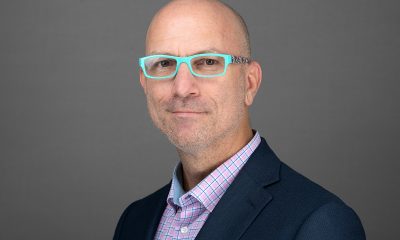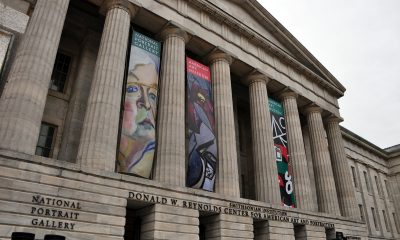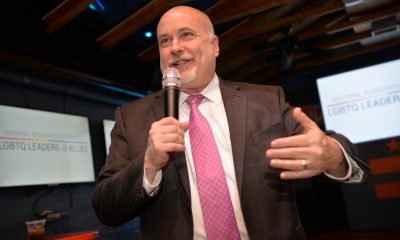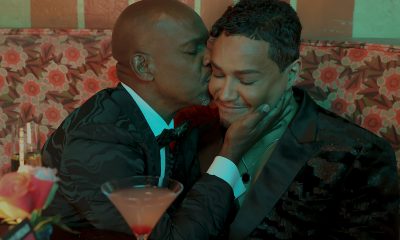Arts & Entertainment
Images and outrage
Controversy aside, ‘Hide/Seek’ is a groundbreaking show
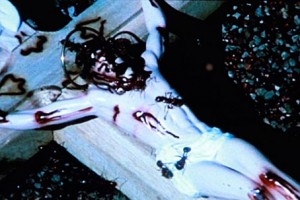
A still from the video that caused controversy in the current "Hide/Seek" exhibit at the National Portrait Gallery.
Catcher Yogi Berra once famously called it “deja vu all over again.” But it was Karl Marx who perhaps defined it best as “when history repeats itself — the first time as tragedy, the second time as farce.”
That was the feeling at least for a moment last week, when officials at the National Portrait Gallery censored a video component of its exhibit titled “Hide/Seek,” the show about gay and lesbian sexual love and its impact on American art. Complaints by right-wing Catholics over 11 seconds of a depiction of ants crawling on a crucifix was enough for NPG director Martin E. Sullivan to decide to turn tail and yank an entire half-hour-long 1987 video, titled “A Fire in My Belly” — a meditation on the ravages of AIDS by David Wojnarowicz, the gay artist who died from HIV-related causes in 1992.
Shades of Robert Mapplethorpe and the cancellation of an exhibit of his erotically charged photos by the Corcoran Gallery of Art in 1989. And now as then GOP politicians are on the attack under the banner of “no promo homo,” and also as before, another gallery — this time Flashpoint — courageously took up the challenge and began to show the offending video.
But what about the groundbreaking NPG show itself, which opened in October and runs through mid-February? It’s stunning with 105 pieces of art from the canon of America’s greatest artists of the past century and more, depicting the ways in which their sexual orientations expressed themselves — usually coded and concealed — visually on canvas and other surfaces and as images in motion.
The exhibit is titled as a playful reminder of the childhood game of hide-and-seek, when concealment is the first task for survival. “HIDE/SEEK — Difference and Desire in American Portraiture,” with its range and breadth of seeing and finding works of art that dare speak, however sotto voce, the name of taboo love, boldly snaps in two the several decades-long taboo, welded firmly in place after the Mapplethorpe fiasco, of acknowledging same-sex desire in major U.S. museums.
The range of artists begins with Thomas Eakins and his scenes of naked boys swimming and passes through other giants of American painting — John Singer Sargent, George Bellow, Georgia O’Keefe, Jasper Johns, Robert Rauschenberg, Andy Warhol and others — to our own new century. But as co-curator Jonathan D. Katz contends, “seeking and noticing” the sexual subtexts of their work “are two very different acts,” and this exhibit “seeks to turn such seeing into noticing.”
As with their work itself, nothing is as it seems at first. Therefore, “HIDE/SEEK” features, says Katz, “straight artists representing gay figures, gay artists representing straight figures, gay artists representing gay figures, and even straight artists representing straight figures, when of interest to gay people/culture.”
For Katz, considered the dean of academic study of gay and lesbian art history, this has been the curatorial work of more than 15 years. Katz shaped this exhibit with Smithsonian historian David C. Ward, who has openly called Katz “my camerado — per Walt (Whitman).”
Ward also says that Katz, who founded the gay and lesbian studies program at Yale University and is the first tenured professor in LGBT studies in the nation, “is a model of the engaged scholar” and as a result ran afoul of academic norms in the past for his avowed interest in these subjects.
“He’s someone who managed to be thrown out of two institutions, the University of Chicago and Johns Hopkins University,” Ward says, “for daring in the 1970s to want to write about gay and lesbian Americans.”
In the magisterial catalogue accompanying the exhibit, Katz confesses that their choice of subjects is “firmly canonical” and rooted in “the register of great American artists … within the American mainstream,” so that many artists, less well known, have been excluded. The key objective, says Katz, is to show that “the assumption that same-sex desire is at best tangential to the history of American art” is “utterly unsupportable.”
With “HIDE/SEEK,” and even with the Wojnarowicz censorship fresh at hand, it now seems safe to say, in Katz’s words, that the “pervasive silencing of same-sex desire in accounts of American portrait painting” is over.
Perhaps the most interesting feature of the exhibit comes in its revelation that American artists at the turn of the 20th century could in fact be much more open about their subject matter than those of the mid-20th century in a period haunted by sexual McCarthyism and the hunt for “reds and gays” in government, the schools and the clergy. During that era only on the fringes of the entertainment world, and there not always, could different sexual proclivities find open or even closeted refuge.
In other words, same-sex desire could be expressed more freely in the arts at that earlier time “prior to the advent of ‘homosexuality’ as an available category,” says Katz, even though same-sex desire acted upon was literally a crime. But this was before an explicit “homo/hetero binary” was established as the enforced norm, he says, and before “gay” and “straight” were paired as strict opposites instead of subtle inflection points on a spectrum of the sort spelled out by Alfred Kinsey in his scale of zero to six.
Key to this transformation, Katz says, was when “sexual behavior evolve(d) into sexual identity, from what you did to what you were.” In the earlier era, after all, sexual identity was premised not on the gender of one’s sexual partner but rather on one’s own gendered role —insertive or receptive — in the sex act. As Katz notes, “it was socially acceptable to penetrate a queer” for sexual relief and as “tolerable stand-ins for women.”
Thus, Katz begins the exhibit catalogue with a searching exegesis of George Bellows’ print from 1917, “The Shower Bath,” where two naked men are depicted front and center – one thin and effeminate, looking seductively over his shoulder and thrusting his posterior provocatively at a second man, beefy of build, butch and masculine, whose towel barely conceals his sexual arousal. Opposites in every way, “they are made a pair,” says Katz, and what he calls “the odd couple” are “the focal point of this image.” But the forward homoeroticism of the Bellows print did not hamper its commercial success at the time. And Bellows himself was a man devoted to his wife and children.
There is, of course much more in this exhibit, with many works coded with layers of longing, that NPG director Sullivan — before the controversy erupted over the video — spoke of “with pride” as offering “a new lens with which to view the panorama of American life.” It is indeed, as he said earlier, “a sumptuous survey of more than a century of American portraiture,” asking “new questions and risking new interpretations.” It dares to be at once risky and risque.
With portraits such as these, we enter the lives of others, to explore how identities were forged in the past. With portraits such as these, we end up staring at ourselves.
Travel
Manchester is vibrant tapestry of culture, history, and Pride
Alan Turning Memorial is among English city’s many attractions
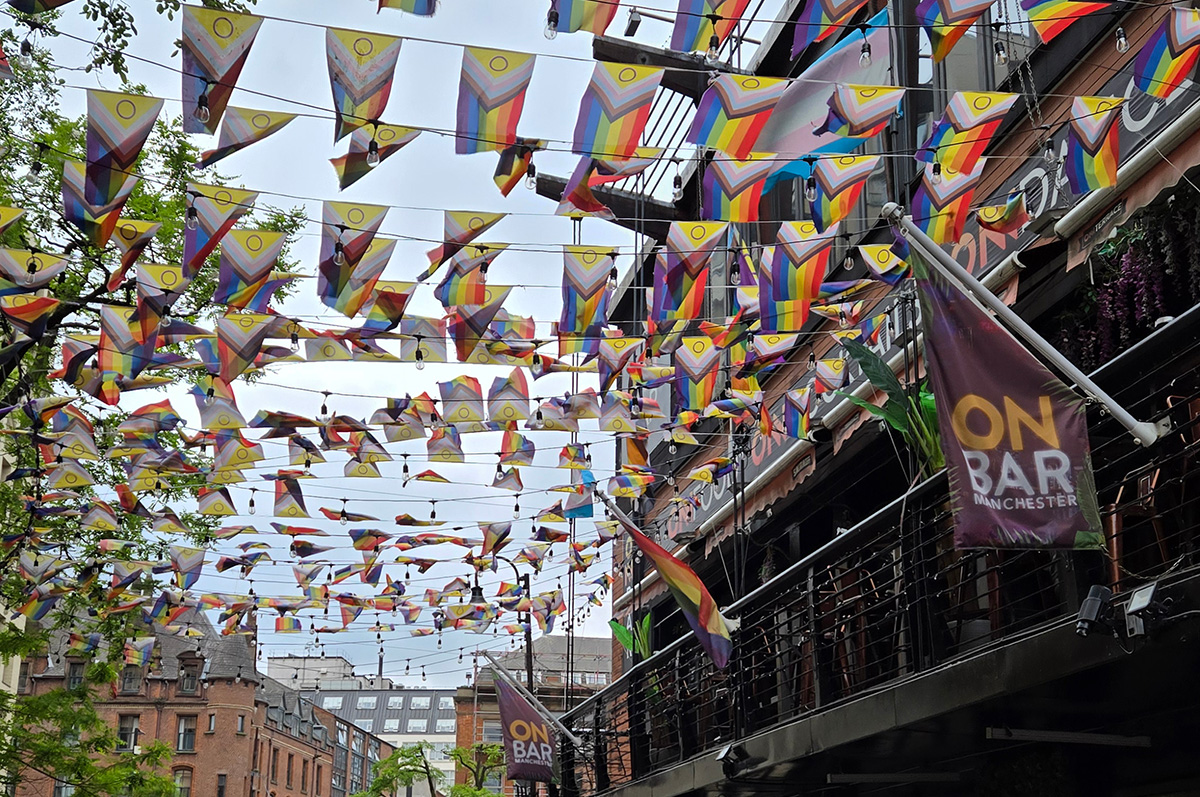
Manchester, England, is not only famous for its industrial heritage, music scene, and football clubs — it’s also home to one of the most vibrant and historically significant LGBTQ communities in the U.K. Often referred to as the “gay capital of the North,” Manchester has been a pioneer in LGBTQ rights, visibility, and celebration, cultivating a culture of inclusivity that continues to thrive today.
The roots of Manchester’s LGBTQ history stretch back centuries, but it was during the 20th century that the city truly became a hub for activism and progress. In 1880, a scandal known as the “Manchester Drag Ball” brought national attention to the city when police raided a fancy dress ball attended by men in drag. Though the incident was used to stigmatize the community, it also marked one of the first widely publicized moments of queer expression in the city.
Manchester is home to several institutions that preserve and celebrate queer history. The LGBT Foundation, based in the city, is one of the U.K.’s leading LGBTQ charities, providing health and support services as well as educational resources.
The city is also immortalized in pop culture as the backdrop for “Queer as Folk,” the groundbreaking 1999 television series created by Russell T. Davies. The show, set in Manchester’s Gay Village, helped bring the realities of LGBTQ life to mainstream audiences and played a pivotal role in shaping public attitudes.
Manchester, is a city that lives and breathes resilience. It’s a place where cobblestone streets echo with the voices of industrial workers, punk rockers, activists, and proud members of the LGBTQ community. I came here seeking stories — some hidden in old libraries, others pulsing through neon-lit streets — and left with a sense of belonging I hadn’t expected.
My base for this journey was the magnificent Kimpton Clocktower Hotel. Located in a former insurance building dating back to the 1890s, it seamlessly marries historic grandeur with modern luxury. Walking through its doors felt like entering a different era. The soaring ceilings, intricate tilework, and dramatic staircases told stories of old Manchester, while the in-room record players spinning tracks by Oasis made sure I knew exactly where I was.
The heart of the hotel is The Refuge, a restaurant and bar that buzzes with energy. Whether sipping cocktails beneath the Winter Garden’s lush greenery or sharing small plates that borrow flavors from around the world, I felt immersed in the city’s welcoming vibe. Even in its luxury, the Kimpton feels like a place for everyone, especially when there is a DJ spinning some cool jazzy beats.
One thing I loved about this property is their “Forgot it? We’ve got it” service. Whether its toothpaste, a shaving kit, or phone charger, the helpful staff have you covered. I tend to forget at least one necessity on every trip. The Kimpton’s central location places guests within walking distance of Manchester’s vibrant cultural scene, including the Palace Theatre, Canal Street, and various shopping and dining options.
My first stop in Manchester was the John Rylands Library, an architectural marvel of neo-Gothic design. I was there specifically to view “The Secret Public” exhibition. It traces Manchester’s underground art scene, especially its ties to queer culture and punk resistance. Flyers, magazines, and photographs are on display.
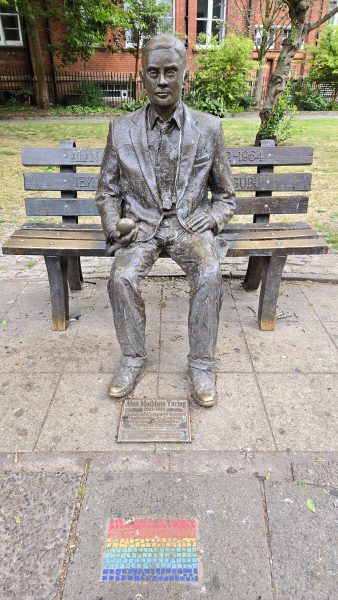
And while we are on the topic of LGBTQ history, the best way to understand Manchester’s queer roots is by talking to the locals. The Free Manchester Walking Tours offers a Queer History Tour, led by passionate guides who have in depth knowledge of the city’s LGBTQ history and culture. We began our tour in Sackville Gardens, home to the Alan Turing Memorial and the Beacon of Hope, a tribute to those affected by HIV/AIDS. It’s a space for reflection, nestled just beside Canal Street’s constant thrum. For those not familiar with Alan Turing, he was a pioneering mathematician and computer scientist, best known for his role in cracking the German Enigma code during World War II, a breakthrough that helped shorten the war and save countless lives. Often regarded as the father of modern computing, Turing laid the theoretical foundation for artificial intelligence. Despite his monumental contributions, he was persecuted for being gay, ultimately leading to his tragic death in 1954. Today, he is celebrated as both a scientific genius and a symbol of the ongoing struggle for LGBTQ rights.
No trip to Manchester would be complete without a night — or three — spent in the Gay Village. Centered around Canal Street, it’s a place that radiates warmth and freedom. What once was a hidden, underground scene in the 1980s has become a global symbol of LGBTQ pride.
During the day, you’ll find people sipping coffee along the canal and by night, the rainbow flags light up the street. Spaces like Via and the Eagle pulse with music and laughter, while Cruz 101 remains a sacred institution for dancefloor devotees. This is more than a party district; it’s a cultural hub, one that has helped shape national conversations and lead by example.
Manchester’s gay scene is more than just nightlife. In the Northern Quarter, I stumbled into Feel Good Club. a queer-owned café that quickly became one of my favorite stops during my trip. Feel Good Club is a café but the space also hosts workshops, mental wellness events, and spontaneous conversations with strangers who somehow feel like old friends. I ordered a bowl of apple-soaked oats and I have to say, it was one of the most delicious and inexpensive things I ate during my entire trip to England. I should have asked for the recipe!
A few blocks away sits Queer Lit, an LGBTQ bookstore filled to the brim with stories I wish I’d had growing up. From queer romance and fiction to books on trans identity and intersectionality, the shop is both cozy and revolutionary. Queer Lit claims to have the largest selection of LGBTQ books in all of Europe. Beyond books, the store hosts events such as workshops, live readings, and book clubs, providing a safe and inclusive space for the community to gather and celebrate queer literature. They also serve a variety of beverages. I would definitely recommend trying one of their hot chocolate drinks.
Though my trip didn’t coincide with Manchester Pride, visitors can expect tens of thousands each August. Pride here features a blend of celebration and activism. From glitter-filled marches to thoughtful panel discussions, it’s a reflection of the city itself: joyful, inclusive, and unafraid to speak truth to power. Importantly, the money raised goes straight back into the community, funding LGBTQ+ health initiatives, charities, and support services. Also in August is SCENE, Manchester’s LGBTQ+ Film and TV Festival, which consists of a week of new and classic LGBTQ cinema and TV screenings, panels, and other events.
All this touring and learning about queer history made me hungry, so for dinner, I ventured to Maray, a Middle Eastern-inspired gem in the city center. Its signature “Disco Cauliflower” — roasted whole and topped with tahini, pomegranate, and harissa — was a revelation. The food, like the city, defied expectations. It was spicy, complex and comforting. I would also recommend trying the crispy sea bass with broccoli slaw. Maray’s vibe is relaxed yet refined, a perfect place to unwind after a day of exploration. Its inclusive, welcoming spirit felt aligned with everything I’d experienced in Manchester so far.
For a more casual dining experience, head over to Freight Island, a unique food hall and entertainment venue located near Piccadilly Station. The venue features a variety of locally owned food stalls including Mia’s Arepas, Ornella’s Little Kitchen and Mega Gyros. It’s a great place to grab a quick bite or cocktail after work with friends.
Manchester may not be as polished as London, but that adds to its charm and intrigue. I tend to enjoy cities like Manchester over their larger neighbors. During my entire stay, I was able to walk to every attraction I visited and by experience, the best way to see a city is on foot. It’s also a great way to burn off those extra calories.
Whether you’re wandering Canal Street at sunset, or simply sipping hot chocolate at Queer Lit, Manchester is a place where you can be yourself and belong.
Enjoy the journey!
Books
Embracing the chaos can be part of the fun
‘Make Sure You Die Screaming’ offers many twists and turns
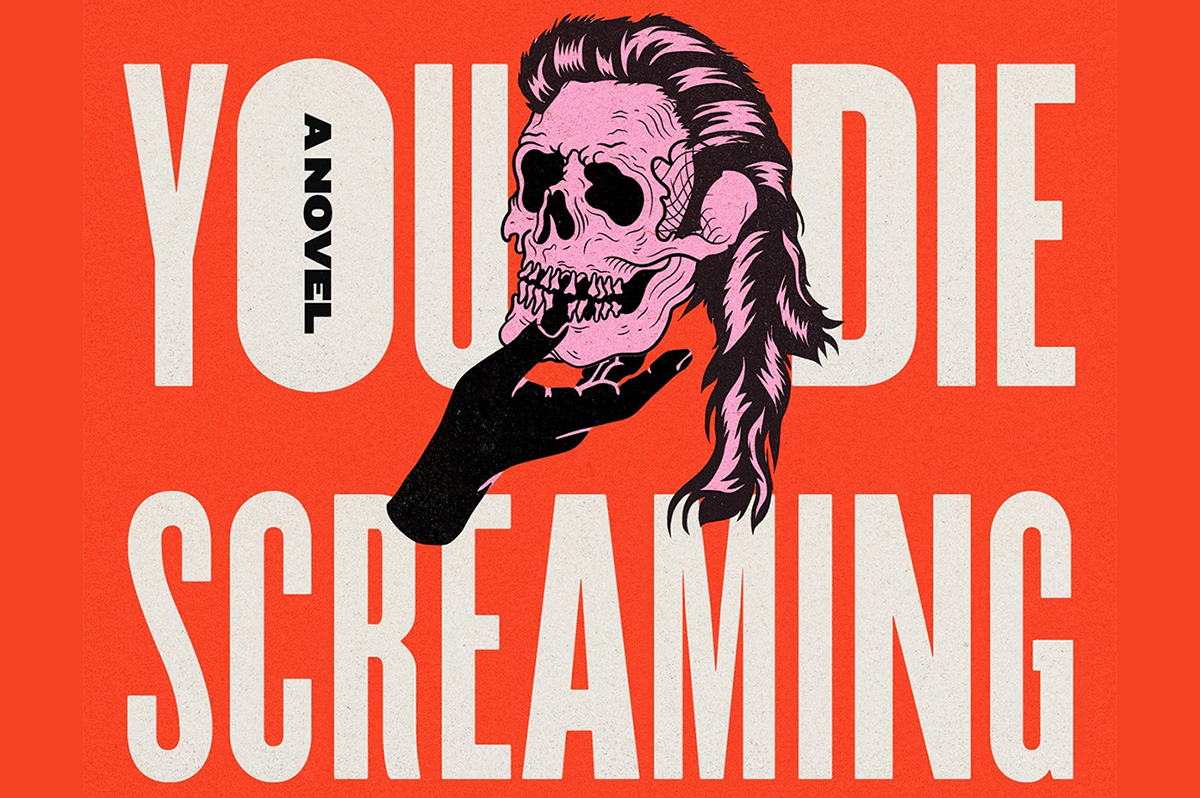
‘Make Sure You Die Screaming’
By Zee Carlstrom
c.2025, Random House
$28/304 pages
Sometimes, you just want to shut the door and forget what’s on the other side.
You could just wipe it from your memory, like it didn’t occur. Or create an alternate universe where bad things never happen to you and where, as in the new novel “Make Sure You Die Screaming” by Zee Carlstrom, you can pretend not to care.

Their mother called them “Holden,” but they’d stopped using that name and they hadn’t decided what to use now. What do you call an alcoholic, queer, pessimistic former ad executive who’s also “The World’s First Honest White Man,” although they no longer identify as a man? It’s a conundrum that they’ll have to figure out soon because a cop’s been following them almost since they left Chicago with Yivi, their psychic new best friend.
Until yesterday, they’d been sleeping on a futon in some lady’s basement, drinking whatever Yivi mixed, and trying not to think about Jenny. They killed Jenny, they’re sure of it. And that’s one reason why it’s prudent to freak out about the cop.
The other reason is that the car they’re driving was stolen from their ex-boyfriend who probably doesn’t know it’s gone yet.
This road trip wasn’t exactly well-planned. Their mother called, saying they were needed in Arkansas to find their father, who’d gone missing so, against their better judgment, they packed as much alcohol as Yivi could find and headed south. Their dad had always been unique, a cruel man, abusive, intractable; he suffered from PTSD, and probably another half-dozen acronyms, the doctors were never sure. They didn’t want to find him, but their mother called…
It was probably for the best; Yivi claimed that a drug dealer was chasing her, and leaving Chicago seemed like a good thing.
They wanted a drink more than anything. Except maybe not more than they wanted to escape thoughts of their old life, of Jenny and her death. And the more miles that passed, the closer they came to the end of the road.
If you think there’s a real possibility that “Make Sure You Die Screaming” might run off the rails a time or three, you’re right. It’s really out there, but not always in a bad way. Reading it, in fact, is like squatting down in a wet, stinky alley just after the trash collector has come: it’s filthy, dank, and profanity-filled. Then again, it’s also absurd and dark and philosophical, highly enjoyable but also satisfying and a little disturbing; Palahniuk-like but less metaphoric.
That’s a stew that works and author Zee Carlstrom stirs it well, with characters who are sardonic and witty while fighting the feeling that they’re unredeemable losers – which they’re not, and that becomes obvious.
You’ll see that all the way to one of the weirdest endings ever.
Readers who can withstand this book’s utter confusion by remembering that chaos is half the point will enjoy taking the road trip inside “Make Sure You Die Screaming.”
Just buckle up tight. Then shut the door, and read.
The Blade may receive commissions from qualifying purchases made via this post.
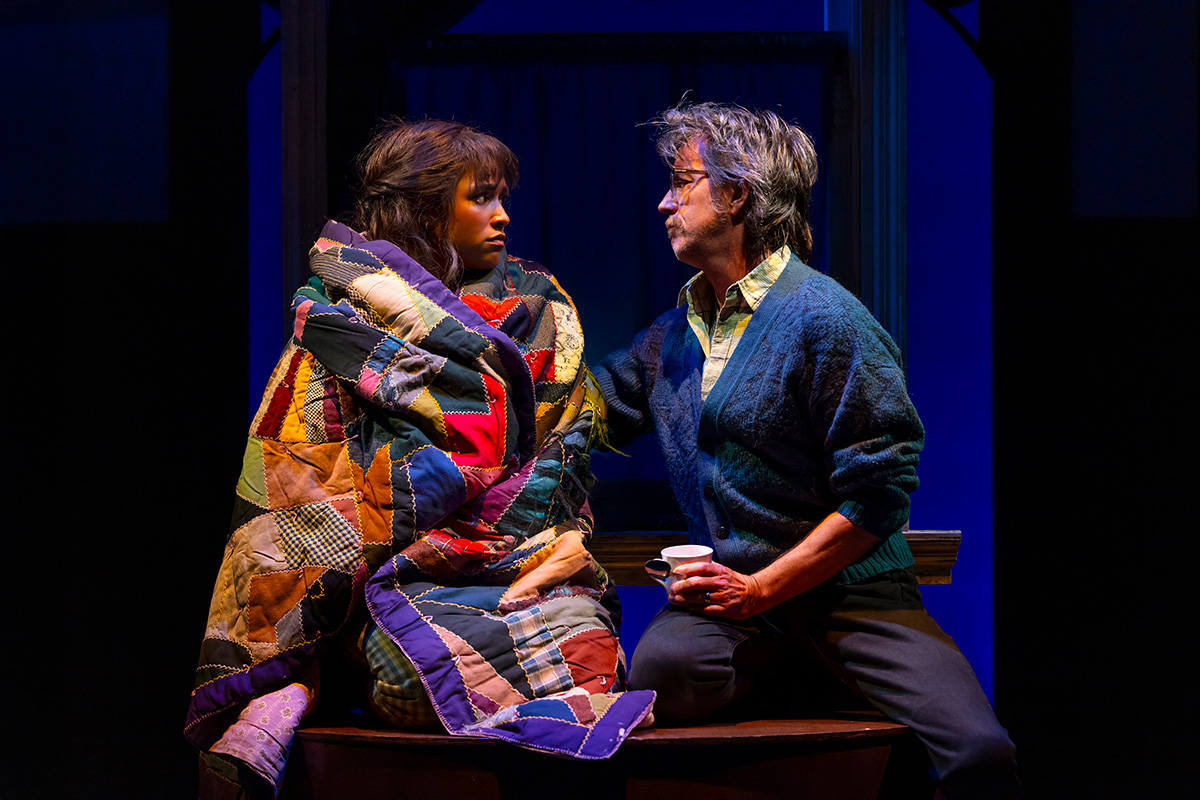
‘A Wrinkle in Time’
Through July 20
Arena Stage
1101 Sixth St., S.W.
Tickets range from $59-$209
Arenastage.org
Currently at Arena Stage, talented out actor and singer Taylor Iman Jones is rekindling an old friendship with an adored character of fiction.
Broadway vet Jones is starring as 13-year-old Meg Murry in “A Wrinkle in Time,” the world-premiere musical adaptation of Madeleine L’Engle’s same-titled book.
For many readers, especially women, the classic 1962 young adult novel, was their first foray into sci-fi, particularly one with a female protagonist.
The story centers on Meg, an awkward schoolgirl whose physicist father has mysteriously disappeared. Now, Meg, her popular friend Calvin, and smart younger brother Charles Wallace are tasked with moving through time and space to find him. Along the way they encounter adventure and evil.
For Jones, 33, playing 13-year-old Meg feels freeing in ways. She says, “As you get older, you’re told to grow up, so I like letting go of some of that. To feel feelings in their rawest form and to tap back into that is fun. I like the spontaneity. There are highs and lows to revisit.”
Born and raised in the San Francisco Bay Area, Jones began piano lessons at just six and soon added band and plays to their pursuits. Following high school, she made a deep dive into California theater for seven years before making the big move to New York in 2017 where after just two months she was singing on Broadway.
The determined and appealing Jones, who lives in New York with their partner, boasts an impressive bio. She has appeared on Broadway as Catherine Parr, Henry VIII’s sixth and final wife in Six, and in the original casts of “Head Over Heels” and “Groundhog Day.” She’s been seen in national tours of “Hamilton” and “American Idiot.”
WASHINGTON BLADE: It seems “A Wrinkle in Time” and Meg mean a lot to a lot of people.
TAYLOR IMAN JONES: The book tells the story of a girl with so much undiscovered power who’s accomplishing things she never imagined that she could.
BLADE: Can you relate?
JONES: Meg wears her emotions on her sleeve. I can certainly relate to that. I’m a Pisces. Sometimes being hyperemotional and very empathetic can feel like a burden, but as I’ve matured, I have realized that it’s not a bad quality. And it’s something I’ve learned to harness and to enjoy. I love that I can play a role like Meg in front of thousands of people.
BLADE: Was “Wrinkle in Time” a book you knew well?
JONES: Oh yeah, it’s a favorite book that lives in my heart and my mind. It’s one of the first books that taught me about the adventure of reading.
BLADE: And playing a favorite character must be a kick.
JONES: It really is.
BLADE: Meg is a big part in a big show.
JONES: This musical is huge. They’re traveling through space and meeting people on different planets. 20-person cast. 30 songs in the show. Quite the undertaking and I’m proud of us. I’m on stage for the entire musical and I sing four or five numbers.
As a mezzo soprano I guess you’d say I have the luxury of being able to do a lot of musicals that span a lot of different genres: rock musical, pop musical, and standards. “A Wrinkle in Time” is contemporary musical theater.
For me, singing is probably the least difficult part of the show. What’s harder for me is the way Meg experiences trauma; I need to be careful when I’m screaming and yelling.
BLADE: It seems mostly women have been involved in making this production happen (book by Lauren Yee; music and lyrics by Heather Christian; directed by Lee Sunday Evans; and choreography by Ani Taj.)
JONES: It’s true, the director, writer, etc., and most of our producers are all women. This doesn’t happen most of the time. For me it means new ideas and fresh energy, and pushing the limits of musical theater.
It’s also created a wonderful space in which to work. It can be more generous, and understanding. And centering the story on a young girl is something we can all relate to.
BLADE: Will “A Wrinkle in Time” resonate with queer theatergoers and their families?
JONES: I think so, especially on the heels of pride month. It’s truly a show for all ages about finding your inner strength and fighting for the things that you love; not letting evil win over the power of good, and not just for yourself but for those around you too.

